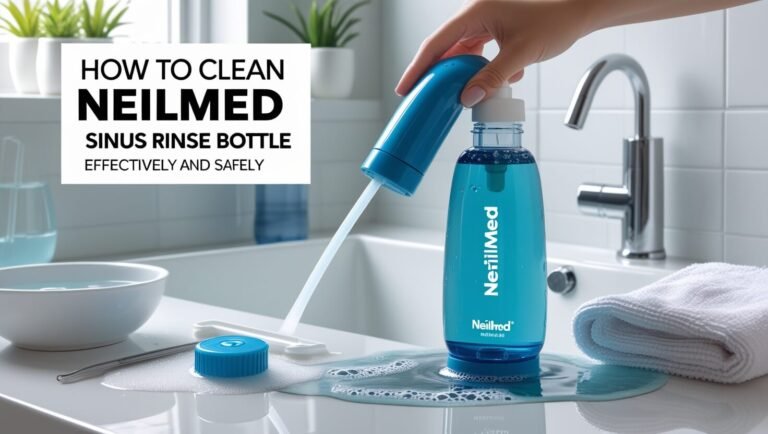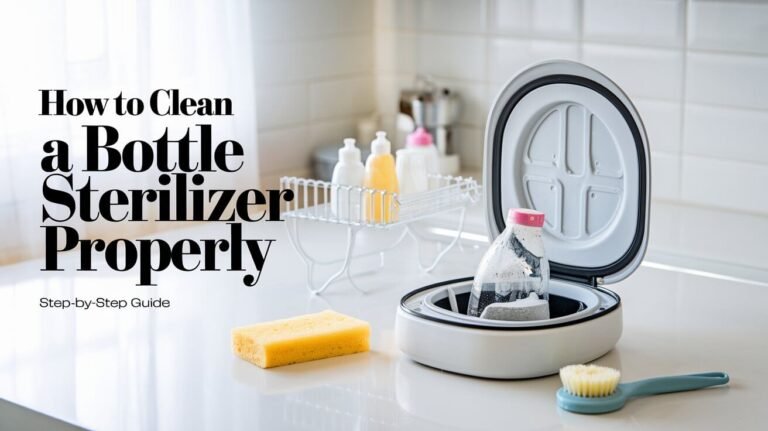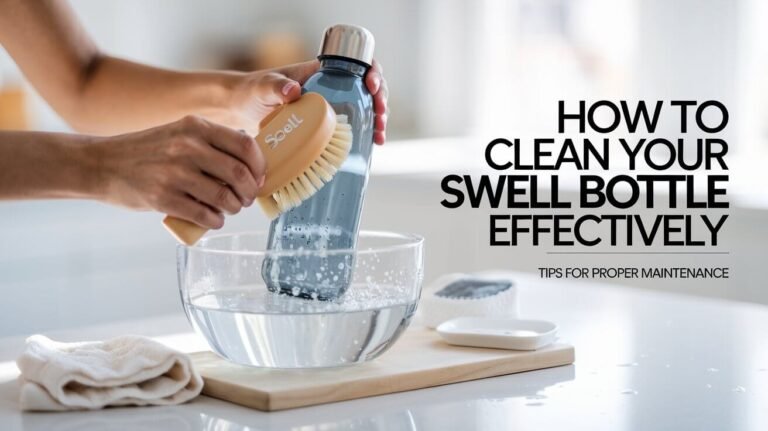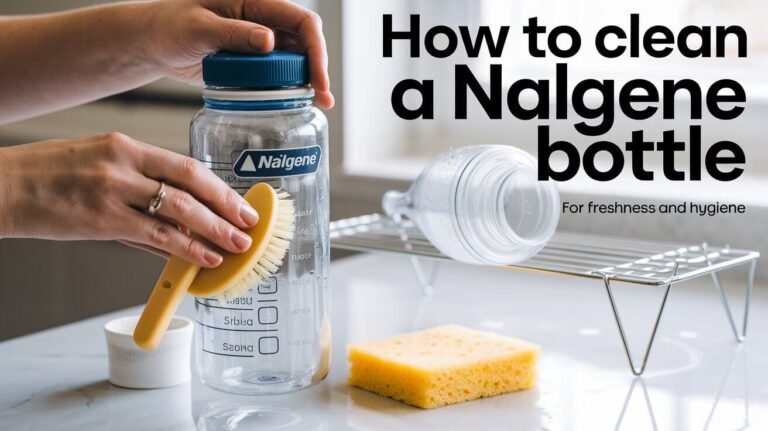How To Clean Olive Oil Bottle: Simple Tips for a Fresh Start
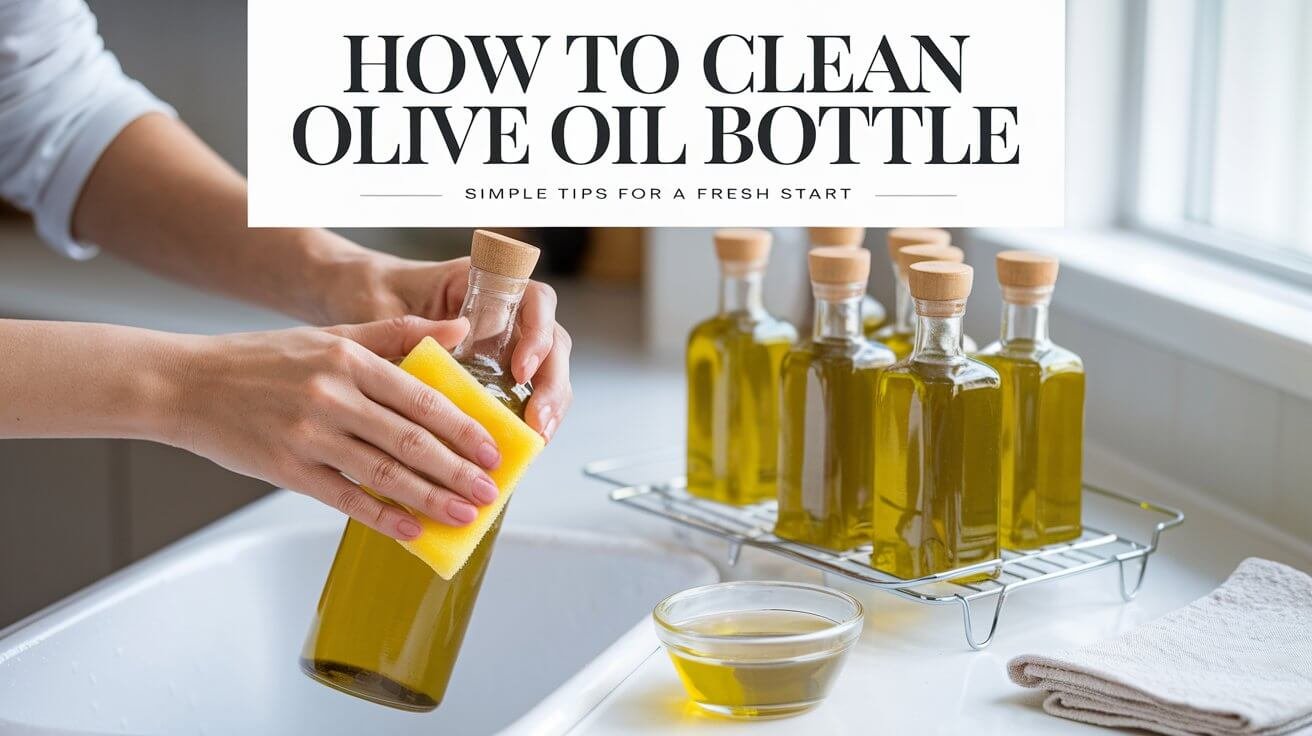
What’s the best way to wash olive oil bottles to keep them clean and free of residue? Cleaning olive oil bottles is key to keeping the oils’ quality and flavor. It’s a task that needs to be done often. Many cooks find it hard to keep storage containers clean, like oil bottles, because of the oil residue.
To find the answer, let’s look into how to clean olive oil bottles and the best tips for doing so.
There are several ways to clean olive oil bottles, including using dish wash liquid and vinegar, uncooked rice, and ash. Some people even use a hairdryer to dry the bottle or fill it with hot water to loosen the residue. But what’s the most effective method, and how can you ensure your oil bottles are clean and dry?
Learning how to clean olive oil bottles is important to prevent residue and contaminants. These can harm the flavor and quality of the oils. In this article, we will discuss the best way to wash olive oil bottles and give you useful cleaning tips.
Essential Tools for Olive Oil Bottle Cleaning
Cleaning olive oil bottles right is key. You’ll need basic cleaning supplies, specialized bottle brushes, and natural cleaners. These easy tricks for cleaning olive oil bottles will help a lot.
First, get your basic cleaning stuff ready. You’ll need dish soap and warm water. These help remove residue and stains. For tough stains, a bottle brush is a must. Natural cleaners like vinegar and baking soda can also help clean and freshen the bottles.
Basic Cleaning Supplies
- Dish soap
- Warm water
- Sponges or soft cloths
Specialized Bottle Brushes
These brushes fit into olive oil bottles’ narrow necks. They make it easy to clean out stubborn stains and residue.
Natural Cleaning Agents
Natural cleaners like vinegar and baking soda are good for the planet. They can clean and deodorize your bottles. Soak the bottle in vinegar water or use baking soda and a soft cloth to scrub.
Hot Water Method for Fresh Oil Residue
To keep your olive oil bottle in good shape, following an olive oil bottle maintenance guide is key. The hot water method is a top way to clean your glass olive oil container. It’s simple and works well for removing fresh oil residue.
Here are the steps to follow for the hot water method:
- Fill the bottle with hot water, leaving about an inch at the top.
- Add a few drops of dish soap to the water.
- Use a bottle brush to scrub the interior of the bottle, making sure to reach all areas.
- Rinse the bottle thoroughly with warm water to remove any soap residue.
- Allow the bottle to air dry, or use a clean towel to dry it.
Use the hot water method to keep your olive oil bottle clean and in good condition. Always check the inside of the bottle for any remaining residue. If you find any, repeat the cleaning process. This will help keep your olive oil quality high and your bottle lasting longer.
| Method | Effectiveness | Ease of Use |
|---|---|---|
| Hot Water Method | High | Easy |
| Dish Soap and Rice Method | High | Medium |
| Vinegar Solution Method | Medium | Easy |
Natural Cleaners for Stubborn Oil Stains
Cleaning olive oil bottles can be tough, thanks to stubborn stains. It’s key to know how to clean them well to keep your kitchen clean. Here, we’ll share top tips for removing tough oil stains.
For hard stains, mix natural ingredients like vinegar, baking soda, or lemon juice. You can soak the bottle in warm water or use a brush to scrub. These steps help get rid of tough stains.
Vinegar Solution Recipe
Make a vinegar solution by mixing equal parts water and white vinegar in the bottle. Let it sit for a few hours or overnight. Then, rinse and dry it well. This method cleans and sanitizes the bottle.
Baking Soda Paste Application
For really tough stains, try a baking soda paste. Mix baking soda with a bit of water to make a paste. Apply it to the stain and let it sit for 30 minutes to an hour. Rinse and dry as usual. This method absorbs oil residue.
Lemon Juice Treatment
Lemon juice is great for removing oil stains. Apply fresh lemon juice to the stain, let it sit for a few minutes, then rinse and dry. The lemon’s acidity breaks down the oil, making it easy to clean.
How to Clean Olive Oil Bottle Spouts
Cleaning the spout of an olive oil bottle is key to keeping it clean. The best way is to take off the spout and wash it with warm water and dish soap. This method stops oil residue from building up after each use.
To clean glass bottles with olive oil residue, use a tiny straw scrubbing brush or a dishwashing sponge. Dish soap that fights grease is great for tough stains. For a deeper clean, soak the spout in a mix of water and white vinegar for 10 minutes. This helps loosen any stuck-on residue.
Here are some tips for cleaning olive oil pour spouts:
- Regularly clean the spout every 1-2 weeks to avoid residue buildup
- Soak in a mix of water and white vinegar for 10 minutes for a deeper clean
- Choose high-quality extra virgin olive oil to reduce residue and clogging
- Go for a spout with a wider opening for easier oil flow
A clean olive oil pour spout keeps contaminants out, keeping the oil fresh and pure. It also makes pouring smooth and hassle-free. By following these steps and tips, you can keep your spout clean and ready for use.
| Cleaning Method | Recommended Frequency |
|---|---|
| Warm water and dish soap | After each use |
| Mixture of equal parts water and white vinegar | Every 1-2 weeks |
Deep Cleaning Methods for Aged Residue
Removing olive oil stains from glass bottles can be tough, but it’s doable. The right techniques and tricks can make your bottle shine. First, know that old stains need a deeper clean.
Using natural ingredients and common items can make great cleaners. For example, baking soda and vinegar can dissolve stubborn stains. Also, hot water with dishwash liquid can soften the residue, making it easier to wipe away.
Salt and Ice Technique
This method fills the bottle with salt and ice, then shakes it hard. The salt’s grit helps remove the stain, and the ice loosens it.
Bottle Soaking Process
Soaking the bottle in hot water and dishwash liquid can loosen and remove old stains. This works best with a bottle brush to scrub off any left-over stains.
Other ways to tackle old stains include using a hair dryer, filling it with hot water, or a rice and ash scrub. These deep cleaning methods and tricks can help remove old stains and keep your bottles looking new.
| Method | Ingredients | Instructions |
|---|---|---|
| Salt and Ice Technique | Salt, ice | Fill bottle with salt and ice, shake vigorously |
| Bottle Soaking Process | Hot water, dishwash liquid | Soak bottle in solution, scrub with bottle brush |
Techniques for Narrow-Neck Bottles
Cleaning narrow-neck olive oil bottles can be tricky, but it’s doable with the right methods. An olive oil bottle maintenance guide should cover the best ways to clean these bottles. Using hot water and dish soap is a top technique.
First, fill the bottle with hot water and add a bit of dish soap. Let it soak for a few minutes. Then, scrub the inside with a bottle brush, getting into every corner. Rinse it well with hot water to get rid of soap and residue.
For tough spots, try a mix of water and white vinegar. This combo can help dissolve stubborn residue. Fill the bottle with it, let it sit, then scrub and rinse.
Other cleaning methods include using a hair dryer or filling the bottle with hot water. These can help loosen and remove residue. But, be careful with heat to avoid damage or breakage.
Here are some extra tips for cleaning narrow-neck bottles:
- Use a soft-bristled bottle brush to avoid scratching the glass
- Avoid using abrasive materials or harsh chemicals, which can damage the bottle or leave residue
- Rinse the bottle thoroughly after cleaning to remove any remaining soap or residue
- Dry the bottle upside down to prevent water spots and ensure it is completely dry
Use proper techniques to keep narrow-neck olive oil bottles clean and in good shape. Always clean gently and avoid harsh chemicals or abrasive materials. This way, you can enjoy your olive oil for a long time. The right top techniques to clean glass olive oil container will help you maintain your bottles.
Dealing with Label Adhesive Removal
Removing label adhesive from an olive oil bottle can be tough. But, there are ways to get rid of it. Learning these methods is key to keeping your bottles clean.
For tips on cleaning olive oil bottles, try oil-based solutions or heat. These can help break down the adhesive. You can use hand sanitizer, rubbing alcohol, or WD-40 to dissolve it.
Methods for Removing Label Adhesive
- Apply hand sanitizer to the label and let it sit for a few minutes before peeling off the label.
- Use a hair dryer to heat the label and loosen the adhesive.
- Apply cooking oil or vinegar to the label to soften the adhesive.
- Use a rubber eraser or a commercial product like Goo Gone to remove the adhesive.
By using these tips, you can remove label adhesive easily. Always test a small area first to avoid damage. With these methods, you’ll learn how to clean olive oil bottles effectively.
| Method | Effectiveness | Surface Safety |
|---|---|---|
| Hand Sanitizer | High | Most surfaces |
| Rubbing Alcohol | High | Most surfaces |
| WD-40 | Medium | Some surfaces |
Sanitizing After Cleaning
To make sure your olive oil bottles are clean and safe, follow a few easy steps. First, clean the bottles using the best method. Then, sanitize them to get rid of any bacteria or leftover residue. This is key when dealing with glass bottles that have olive oil residue, as it can change the oil’s taste and quality.
To sanitize olive oil bottles, rinse them with warm water. Then, use a mix of equal parts water and white vinegar. This combo is gentle but effective in removing residue and sanitizing the bottle. For tough residue, soak the bottle in hot water for a few hours before sanitizing.
Safe Sanitization Steps
- Rinse the bottle with warm water to remove any loose residue
- Mix equal parts water and white vinegar in the bottle
- Let the solution sit for 10-15 minutes to allow it to sanitize the bottle
- Rinse the bottle thoroughly with warm water to remove any remaining solution
Drying Techniques
After sanitizing, dry the bottle well to avoid water spots or mineral deposits. You can dry it with a clean towel or let it air dry. For faster drying, use a hair dryer on a low setting. This method ensures the bottle is dry and ready for use.
Prevention Tips for Future Use
Keeping your olive oil bottle clean is key to its longevity. A good olive oil bottle maintenance guide will tell you to clean and dry it often. Use top techniques to clean glass olive oil container like mild soap and warm water. Dry it well after each use.
To avoid residue and stains, follow these tips:
- Store the bottle in a cool, dark place to prevent heat and light exposure.
- Keep the bottle tightly sealed after opening to prevent air from entering and causing oxidation.
- Use a clean and dry cloth to wipe the bottle and prevent water spots.
Keep your olive oil bottle clean and well-maintained with proper storage. This ensures your olive oil stays fresh and of high quality. Always check the best-by date and store it properly to preserve the oil’s quality.
Storage Solutions for Clean Bottles
After cleaning your olive oil bottle, it’s key to store it right to keep it clean. Knowing how to clean and store your bottles is important. This helps prevent contamination and keeps your oil fresh longer.
When storing clean olive oil bottles, consider a few things. These include the best storage conditions and how to control moisture. Here are some tips for storing your bottles:
Ideal Storage Conditions
Keep your bottles in a cool, dry spot away from sunlight. This stops mold and mildew from growing. You can also store them in ceramic cruets. These have thick walls that block out light, air, and heat.
Moisture Control Methods
Make sure your bottles are dry before you store them. Use a clean towel or let them air dry. This stops bacteria and other microorganisms from growing. Also, use a desiccant or silica gel packets to soak up moisture in the area.
Store olive oil properly to keep the bottles clean and fresh. Always check your bottles for damage or contamination before storing. Clean them regularly to avoid residue and bacteria buildup.
Simple Habits for Spotless Bottles
To keep your olive oil bottles clean, start by rinsing them with warm water and a bit of dish soap right after use. This stops oil residue from sticking and makes cleaning easier later. Also, use a bottle brush to clean inside, making sure every spot is clean.
For a deeper clean, mix warm water with baking soda or vinegar in the bottles. Let it soak for 30 minutes, then scrub and rinse well. It’s important to dry the bottles completely to avoid moisture and bacteria. You can use a hair dryer or warm oven to dry them fully.
By following these easy cleaning habits, your olive oil bottles will always be ready for use. Spending a little time on cleaning will make your kitchen look great and make cooking and cleaning easier.
Usual Questions:
Why is it important to clean olive oil bottles?
Cleaning olive oil bottles keeps the oil’s quality and taste good. It’s best to clean them every three months or at least once a year.
What tools are needed to clean olive oil bottles?
You’ll need dish soap and warm water. Also, bottle brushes and natural cleaners like vinegar and baking soda are helpful.
How do I use the hot water method to clean olive oil bottles?
Fill the bottle with hot water and add a bit of dish soap. Use a bottle brush to scrub it. Then, rinse it well with warm water and let it dry.
What natural cleaners can I use to remove stubborn oil stains?
Vinegar, baking soda paste, and lemon juice can remove tough oil stains. They are natural and effective.
How do I clean the spout of an olive oil bottle?
Take off the spout and wash it with warm water and dish soap. Clean it separately.
How can I remove aged residue from olive oil bottles?
Use the salt and ice technique or soak the bottle to get rid of old residue. These methods are deep cleaning.
How can I clean narrow-neck olive oil bottles?
Use specialized bottle brushes and targeted cleaning methods for narrow-neck bottles. This ensures a thorough clean.
How can I remove label adhesive from olive oil bottles?
Oil-based solutions or heat can remove label adhesive. These methods are effective and safe.
How do I sanitize olive oil bottles after cleaning?
Rinse the bottles with warm water and then sanitize them safely. This keeps them clean and germ-free.
How can I prevent residue and stains from forming on olive oil bottles?
Clean and dry the bottles regularly. Also, follow prevention tips to avoid residue and stains.
How should I store clean olive oil bottles?
Store them in ideal conditions and use moisture control methods. This keeps the bottles fresh and clean.
How can I maintain spotless olive oil bottles?
Clean and dry the bottles often. Simple habits like this keep them spotless and ready to use.

